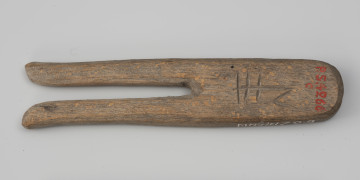
Fish net needle
1900 — 1950
National Museum in Szczecin
Part of the collection: European classics of modernity
Adam Marczyński, one of the young artists associated with the first Kraków Group in the years 1933-1934, shared with his colleagues a socially committed attitude and abstract visual language. Following the example of Pablo Picasso or Fernand Léger, the young artists composed organic arrangements of colourful spots and flexible lines. When Marczyński joined the Trade Union of Polish Artists in 1936, the association was busy defending the fundamental labour rights of its members. The outbreak of the Second World War resulted in the departure of many Cracovians to Soviet-occupied Lvov, where Marczyński held the post of librarian of the Union of Visual Artists of Western Ukraine. During his year-long stay in Ukraine (1940-1941), the artist became familiar with the method of socialist realism. After the end of the Nazi occupation, as a member of the board of the Kraków branch, he joined the reorganisation of the association whose aims were summed up by five slogans: securing the material existence of artists, reforming education, ensuring the synthesis of individual art media, recognising art as a branch of the national economy and popularising the discipline. Still balancing on the border between abstraction and realism, Marczyński represented the modern attitude of artists involved in the so-called interregnum of 1945-1948. The fishbowl motif, appearing during the famous Krakow Modern Art Exhibition (1948/1949) in the works of Maria Jarema, Maciej Makarewicz or Marek Włodarski, was one of the favourites in this environment. Marczyński's predilection for marine themes persisted throughout the Stalinist period, finding an outlet in monotypes and oil paintings during the thaw. Since the end of the fifties, when in the field of independent art the artist was preoccupied with post-painting experiments, cubistic stylization was still present in his decorative sacral realizations.
Szymon Piotr Kubiak
Author / creator
Dimensions
cały obiekt: height: 69 cm, width: 61,5 cm
Object type
painting
Creation time / dating
Creation / finding place
Identification number
Location / status

1900 — 1950
National Museum in Szczecin

1900 — 1950
National Museum in Szczecin

1890 — 1950
National Museum in Szczecin
DISCOVER this TOPIC
Museum of King Jan III's Palace at Wilanów
DISCOVER this PATH
Educational path